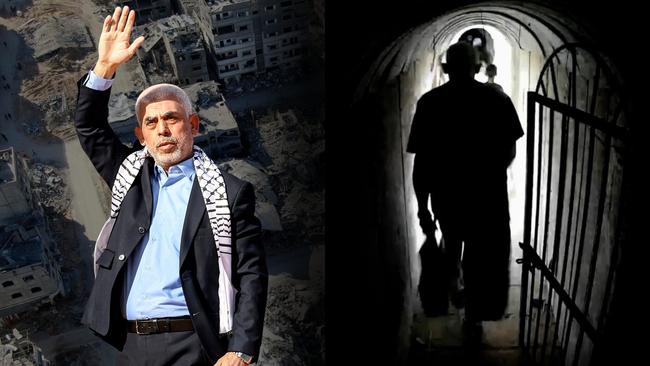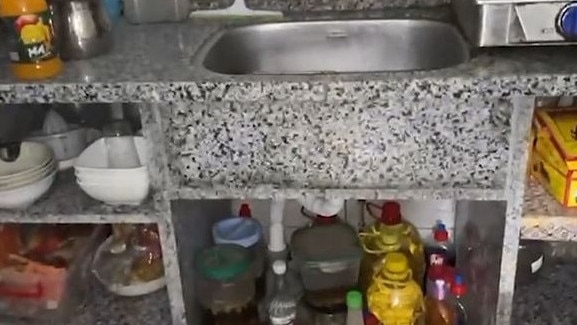Hidden in Gaza’s tunnels for nearly a year, how does Hamas leader Yahya Sinwar communicate?
Fleeing from one underground complex to the next, Yahya Sinwar stays in close contact with his commanders using methods that could have come out of a spy manual, with hand written letters and ancient phone lines.

As critical ceasefire negotiations between Israel and Hamas take place in Doha in a “final stage bid” to end the conflict and avert a wider regional conflict, Hamas leader Yahya Sinwar is front and centre of the talks – despite not only not being present, but refusing to send representatives from the militant group.
Sinwar, who took the top role after the assassination of Ismail Haniyeh in Tehran in late July, has let negotiators know, via Hamas official Osama Hamdan, the group would join indirect negotiations if Israel made new commitments toward a permanent ceasefire.
As the talks inch forward, every stage of the negotiations must be cleared with Sinwar before they can move on. But with Sinwar living in hiding in the vast tunnel network under Gaza, communication with Hamas’ new leader is a vastly complicated – and frustratingly slow – process.

Sinwar has been in hiding since the October 7 massacre in Israel, which he orchestrated. Israeli Defence Forces have decimated Hamas’s leadership – killing not only Haniyeh but military chief Mohammad Deif, leader of the Ezzedeen al-Qassam Brigades, the group’s military wing. It leaves Sinwar as last man standing at the top of the group which has been devastated by continuing Israeli strikes.

The Israeli military has announced that his only future is that of Haniyeh and Deif, and are concentrating efforts on finding and killing him. Earlier this week, an IDF commander admitted that troops had entered one of Sinwar’s hiding places only minutes after he had left. Sinwar had fled so recently the coffee was “still hot,” Brigadier General Dan Goldfus told reporters.
“We were close. We were in his compound. We got to an underground compound … We found a lot of money there. The coffee was still hot. Weapons strewn around,” he said.
In March, The Israeli Defence Forces aired a video of another compound where Sinwar and other Hamas leaders hid in the wake of the massacre. The footage showed a series of rooms including two bathrooms, a well-equipped kitchen, and a sleeping area with uniforms spread out on a bed. It also showed a room which the IDF said was Sinwar’s private room, and which held a safe in which they said they found millions of shekels and dollars.
The mystery is how Sinwar has continued to communicate with leaders in his organisation while staying one step ahead of the Israeli military and its formidable intelligence services.
According to reports in Iranian media, he has abandoned mobile phones, which can all too easily be traced, reverting to methods that could have come straight from a spy manual.
Favourite among these methods are hand written notes and verbal communication with a small circle of trusted aides, via a chain of Hamas members – none of whom have any knowledge about the other links in the complex chain.

From the start of the Gaza war, Sinwar has sent messages and commands in notes that he has either handwritten or typed and signed, and in voice recordings that are hand delivered in secret, the Asharq Al-Awsat newspaper reports.
Hamas sources in Gaza told Asharq Al-Awsat no one within the movement knows exactly where Sinwar is except for the small circle that serves as a link between him and the leadership. “These few individuals ensure his needs are met and facilitate his communication with the leadership inside and outside Gaza using complex methods,” the sources told the newspaper.
It’s understood that Sinwar’s brother, Mohammed, who is also a senior commander in Hamas’ al-Qassam Brigades – and a major target of the IDF – plays a central role in his communications. Mohammed, also known as Ibrahim, was caught on Hamas’ own CCTV earlier this year leading Sinwar and his family through a network of tunnels on October 10, days after the massacre.

According to Arab media, Hamas leaders relied at the beginning of the war on the movement’s communications lines, which the group’s military engineers had developed as early as 2009, and began developing them using foreign technology.
Asharq Al-Awsat claims Hamas’ military wing installed underground telephone centres connected to old communication lines placed at various above ground sites and Sinwar uses these lines to communicate with commanders above ground. The IDF is aware of these lines of communication and has repeatedly tried to hack them – and to destroy them outright – but with little luck so far.
Sinwar’s communications with Hamas leaders abroad are more complicated. According to Asharq Al-Awsat and Arab media, messages are transmitted out of Gaza using a variety of methods including via the internet using electronic chips and encrypted software purchased abroad.
The IDF remains confident it will eventually find and kill Sinwar, declaring he’s “marked for death.”
The military has this month launched another operation on the southern city of Khan Younis, Sinwar’s home town, including dropping leaflets urging residents to turn him in, and offering a bounty of US$400,000 for information on him.
Hamas is confident that even if Khan Younis citizens were tempted by the leaflets and the reward, they couldn’t possibly pass any critical information to the IDF about their leader’s whereabouts.
“None of the civilians targeted by Israel know where Sinwar is, or whether he’s above or below ground,” a member of Hamas boasted to Arab media.




To join the conversation, please log in. Don't have an account? Register
Join the conversation, you are commenting as Logout